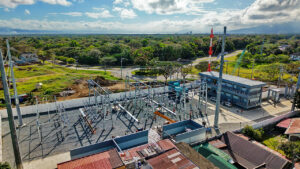Farm producers could target PHL after US tariffs

By Kyle Aristophere T. Atienza, Reporter
US FARM exporters locked out of markets by retaliatory tariffs could target the Philippines, crowding out domestic producers, industry officials said.
“If US producers face retaliatory tariffs, they might seek alternative markets, including smaller countries like the Philippines,” former Agriculture Secretary William D. Dar said via Viber.
“This could lead to an influx of cheap US agricultural products, undercutting domestic producers and harming local farmers’ livelihoods,” he added.
Former Agriculture Secretary Leonardo Q. Montemayor said the Philippines could also be targeted by producers that can no longer export to the US because the tariffs make their products less competitive, causing them to “dump” their excess produce here.
There is also a risk that US producers “will try to look for alternative markets and could end up selling their excess supply to us at very low prices,” he added.
“In the end, it might be our own farmers who will bear the brunt of the Trump tariffs.”
The US will charge Philippine exports a 17% tariff, which officials have noted will give the country an advantage over economies in the region that make similar products.
In Southeast Asia, Cambodia faces the steepest tariff at 49%, followed by Laos (48%), Vietnam (46%), Myanmar (45%), Thailand (37%), Indonesia (32%), Malaysia (24%) and Brunei (24%). Singapore, deemed by the US to be an open economy, is being charged a baseline tariff of 10%.
The Philippines had a trade surplus with the US of $4.9 billion in 2024.
Mr. Dar said focusing solely on tariff differentials is “insufficient,” as other countries are likely to double support for their agriculture industries to offset the tariff regime’s impacts and maintain their competitive advantage.
“The Philippines must consider broader competitive factors,” he said.
“If competing countries provide subsidies or other support to their exporters, they can offset the tariff impact, maintaining their price advantage,” he added.
“In our case, farmers and exporters are basically left to fend for themselves,” Mr. Montemayor said.
Mr. Dar noted that the level of agriculture resilience varies across Southeast Asian, with some having more diversified export markets and stronger agricultural infrastructure.
“Increasing the efficiency of the Philippines’ agricultural practices is essential in maintaining its market share in global trade,” he said.
“Any method that contributes to lowering the price of goods to consumers in foreign markets will be heavily favored in the consideration of being chosen for admission to US markets,” he added.
Mr. Montemayor said among those highly vulnerable to the tariff regime are the Philippines’ 3.4 million coconut farmers, who may see a downturn in copra prices if foreign demand slows down.
In 2023, the Philippines exported nearly P22 billion worth of coconut products to the US.
Processed fruits and seafood are also among the Philippine products affected by the new tariffs, Mr. Dar said.
Samahang Industriya ng Agrikultura (SINAG) spokesman Jayson H. Cainglet said the Philippine products that will be most affected by the new tariff rate are semi-processed goods like coconut oil, desiccated coconut, canned pineapple, and coconut water.
Philippine agricultural exports in January rose to $715.25 million from $538.68 million a year earlier, according to the Philippine Statistics Authority (PSA).
Agricultural exports accounted for only 29.4% of two-way agricultural trade, which was valued at $2.43 billion for the month. Exports of farm goods accounted for 11.2% of total exports.
The PSA said exports of animal, vegetable, or microbial fats and oils and their cleavage products, prepared edible fats, and animal or vegetable waxes accounted for 36.9% or $263.87 million of all agricultural exports.
In 2024, the Philippines imported about two and a half times more agricultural products than it exported both to the US and the world, according to the Federation of Free Farmers.
The US market accounted for around 17% of total Philippine agricultural trade.
Ateneo de Manila economics professor Leonardo A. Lanzona said the Philippines should see the tariff regime as an “opportunity to develop its manufacturing.”
“Whatever export earnings we have gotten from microchips are now going to diminish. So, if food prices rise globally, agriculture products are the best option we have in terms of replacing microchips as our top export,” he said in an e-mail.
Top Philippine exports to the US are integrated circuits, office machine parts, and semiconductors.
Retired agriculture professor Roy S. Kempis, who now heads a business center at the Angeles University Foundation, said in discussing trade differentials, the Philippines should also see how the new tariff rates will increase the prices of supplies and materials that go into the production and sale of exportable goods.
He said the Department of Trade and Industry and the Department of Science and Technology will play key roles in boosting the competitiveness of Philippine agriculture products.
He cited the need for improvements in the areas of phytosanitary compliance, vacuum-packing, and labeling.
Mr. Cainglet of SINAG said tariffs should not be used to kill competition but level the playing field, noting that a proposed agreement on agriculture at the World Trade Organization has been facing a 24-year-old impasse “because countries are choosing to protect local agriculture and domestic markets against the influx of heavily subsidized agriculture imports.”
“Tariffs protect local industries maintain market share and protect jobs in key sectors,” he said via Viber.
The Philippines has lowered tariffs for key Philippine imports including rice, the duty for which is set at 15% from 35% previously.
“In general, increasing tariffs mean additional subsidies for local agriculture and local industries, or to fund social programs,” Mr. Cainglet said.
“If we do not do our homework and the US eventually withdraws these tariff hikes, we will be back to zero and lose our position again to other countries,” Mr. Montemayor said.




